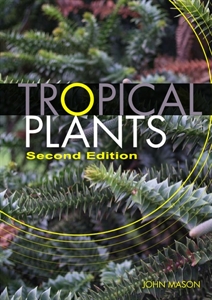Product Description
This book contains sections on the tropical climate, applications for tropical plants, as well as information on growing tropical plants indoors.
Everything you need to know about understanding the growth of tropical plants, managing it and working with it is included here. There is information on soil and fertilisers (including potting soils and dealing with situations unique to tropical climates such as the rapid breakdown of fertilisers and organic materials). Other soil problems are also explored, such as cultivating plants in the very alkaline soils found on coral islands and shell beach areas. Water management is critical in the tropics, and is covered in detail, including practical advice on different ways to apply and conserve water. Other chapters include planning your garden, container gardening, even utilising hydroponic techniques. The last part of the book deals of particular types of tropical plants, such as flowering trees, shrubs and climbers and herbaceous plants (including annuals, perennials, bulbs, etc.) , as well as foliage plants like ferns, palms, philodendron, cordyline and others. Tropical Fruit plants are also included.
A FANTASTIC REFERENCE FOR GARDENERS, HORTICULTURISTS, LANDSCAPE PROFESSIONALS, NURSERYMEN AND PLANT ENTHUSIASTS
This book is an excellent starting point for successful gardening in the tropics and sub tropics. It is not a comprehensive manual, but it does deal with a large variety of the most commonly grown plants. The information is based upon personal experiences of the author (John Mason) and his staff at the Australian Horticultural Correspondence School, cross referenced with reputable references from South East Asia, the Pacific and other parts of the world.
Lush growth, vivid colours and a warmth in the air which makes anyone feel relaxed; these are what we strive for in a tropical garden. All too often though, we get uncomfortable sweltering heat, wilting plants and armies of insects that eat the garden faster than it grows. This book shows you how to get closer to the first of these options, and ways of overcoming those problems which are particular to gardens in warm climates.
TROPICAL AND SUB TROPICAL GARDENS
An Extract from the Unedited Manucscript:
VINES & CLIMBERS
Climbers and vines can both save you money and help keep your garden and home cool. Perhaps the cheapest and often fastest way of fencing a property or creating a screen (to block a view), is to build a simple structure from wire or timber and grow climbers over it. It doesn’t matter what you use, or how ugly it looks, as long as it is solid enough to hold the climbers. Once the climbers grow, you won’t see the structure, unless you are using a deciduous climber, in which case greater care must be taken to produce a supporting structure that is more attractive.
Grown over the wall of a building, climbers provide insulation for inside. Plants grown over a wall or roof of a building can reduce the amount of solar radiation hitting the building by as much as 70%. Likewise in winter the plants will help reduce the amount of heat lost from the building to the atmosphere. It is important, however, to make sure that any climbers used do not damage the building. Check annually, particularly those climbers with invasive aerial roots, and remove if necessary.
On a pergola, shade house or gazebo climbers can be used to provide shade. If more light is desired in cooler months, then deciduous climbers can be used. Many climbers have a trailing, scrambling nature when grown on the ground without some supporting structure. Grown this way they can be excellent ground covers, shading out weeds, or can be used to cover unsightly objects low to the ground, such as retaining walls. Smaller less vigorous climbers can be used to create attractive hanging baskets.
SOME CLIMBERS/VINES TO TRY
ALLAMANDA (Golden Trumpet)
Many can be grown as a bush or climber. They like plenty of water while growing, and prefer a sunny position. Prune after flowering to promote new flower bearing shoots. Foliage can be poisonous. Scale insects sometimes a problem.
Varieties:
A. cathartica Bright yellow flowers 8-10 cm dia, usually 2-3 metres tall (but reported to 12 metres), does well on infertile soil, perhaps the most commonly grown variety, there are a number of different named varieties varying in size, vigour and flower colour.
A. grandiflora Large flowers (to 12 cm diameter) (cultivar of A. cathartica).
A. neriifolia Yellow flowers with orange stripes in the throat, less of a climber, shade tolerant.
A. nobilis Fragrant flowers (cultivar of A. cathartica).
A. schottii Yellow flowers, less of a climber than others (cultivar of A. cathartica).
A. violacea Reddish purple flowers 6-8 cm dia, often grafted onto A. cathartica cultivars such as ‘Hendersonii’ of ‘Schottii’.
ANTIGONON (Coral Vine)
Fast growing, best in protected position (extreme sun or wind will burn foliage), needs moist but drained soil, propagate by seed or cuttings.
Varieties:
A. leptopus Bright pink flowers in summer, to 10 m tall, will survive in cooler areas but may loose some leaves over winter.
A. leptopus album White flowers
BAUHINIA
Most Bauhinias are trees or shrubs, but some are ramblers. These are excellent as ground covers, but they can be attacked by leaf eating insects & scale. Propagate from semi-hardwood cuttings.
Varieties:
B. corymbosa Climber, flowers pinkish or white with pink veins.
B. kockiana – Rambler, excellent in wet tropics.
B. Vahlii Creeper/climber to 30 m, rare, yellow flowers to 7 cm across, leaves up to 30 cm long.
B. yunnanensis Climber, pink flowers, vigorous.
BIGNONIA
Bignonia was divided into a number of genera; and several different climbers are to be found amongst the Bignonia group, including species of Pandorea and Thunbergia. Most are tropical or sub-tropical, though many do adapt to cooler areas.
BOUGAINVILLEA
There are many different varieties of Bougainvillea. Some are well suited to use as a climber, but they do need to be tied into position, and pruned to shape. Other varieties are totally unsuited to use as a climber, and are better treated as a bush. There are many different flower colours -flower colour can change under different environmental (light and humidity) conditions though, making identification of varieties difficult. The small insignificant flowers are surrounded by larger, usually spectacular bracts.
Bougainvilleas like a sunny position and thrive on neglect. Soil is often better kept on the dry side, though watering can be of benefit during a drought or extreme heat. Feeding is generally unnecessary, except perhaps when planting out. Avoid disturbing the roots when planting; don’t cultivate around the roots and avoid transplanting. Propagate by cuttings
VARIETIES
Only three species (out of 18) are widely cultivated:
B. glabra Climbing shrub with small thorns hooked at the tips, white to cream flowers all year surrounded by spectacular bracts, leaves hairy.
B. peruviana A prickly climbing spreading shrub, with thin thorns, yellowish flowers on strong growth in response to dry weather, leaves not hairy.
B. spectabilis Large climbing shrub with sturdy thorns, pale cork like bark, hairy leaves and stems. Cream flowers, mainly during dry seasons.
Three main groups of hybrids are also widely grown:
B. X buttiana (glabra X peruviana) Large woody open climber, strong straight thorns, leaves not very hairy, Cream to cream and pink flowers all year surrounded by large bracts of varying colour; mutations from this group have produced a range of double bracted varieties, including Thai Gold, Pagoda Pink, Klong Fire and Limberlost Beauty.
B. X spectoperuviana (spectabilis X peruviana) includes plants with two different colours in the flower.
B X spectoglabra (spectabilis X glabra)
There are also a range of variegated leaved types which have developed from sports off other varieties.
Some of the more popular varieties grown include:
Coconut Ice Variegated cream & green leaves, double white bracts with pink tips, medium thorns, medium size.
Klong Fire Double red, perhaps the most popular bougainvillea, has many different names, strong medium thorns, typical buttiana habit.
Raspberry Ice Variegated grey-green leaf with cream margin, new shoots reddish, smaller, bush habit, but can eventually grow large if left unpruned.
Scarlet O’Hara New shoots dark red, young flower bracts are orange shaded red, lots of thorns, seasonal flowering.
Thai Gold Tight bunches of many small bracts starting orange and fading to pink, an open upright habit.
CEROPIGIA
Small trailing plants often grown in a container, as a hanging basket, indoor plant or shadehouse plant. They prefer well drained soils. Propagated easily from cuttings. Seed production is uncommon.
Varieties:
C. debilis Small elongated almost insignificant leaves, greenish white tinged purple flowers with dark centre.
C. Woodii (Chain of Hearts) Heart shaped leaves, pink and black tubular flowers.
CLERODENDRUM
Twining climbers which may need some training and tying. They need plenty of light, but must be well protected, particularly from wind. They require a reasonably fertile, moist but well drained soil for best results. Propagate by seed or semi-hardwood cuttings.
C. splendens (Glory Bower) Bright red flowers.
C. Thomsoniae (Bleeding Heart) Flowers have large white bracts surrounding red flowers. The cultivar ‘Delectum’ has rose-magenta flowers in large clusters.
COLUMNEA
Trailing plants, ideally suited to hanging baskets, Needs heat and humidity. Does not tolerate dry conditions. Tubular flowers are spectacular, usually in shades of red or yellow.
There are many hybrids and cultivars available.
Varieties:
C. gloriosa Hairy, pendulous stems. Ovate-oblong leaves often with purplish or red hairs. Scarlet and yellow flowers.
C. magnifica Scarlet flowers.
C. microphylla Smaller leaves, scarlet and yellow flowers
C. Schiedeana Dull yellow flowers with maroon to scarlet spots and lines.
CONGEA
Responds to infrequent pruning, prefers moist, but well drained soils.
Varieties:
Congea rubra Pink flowers.
Congea tomentosa Silver white to lilac flowers, from Thailand.
Congea velutina Mauve-pink flowers, from Malaysia.
FICUS (Fig)
Though most figs are trees, a few are climbers. All have a milky sap. These are usually hardy plants, though they generally respond well to additional moisture. Most are vigorous and can eventually cause structural damage to buildings if left unchecked. They may be best confined to a container.
Easily propagated by cuttings or layering.
Varieties:
F. pumila (Climbing Fig) has green leaved and yellow variegated leaved varieties (cv ‘Variegata’).
Stems with small glossy oval leaves. This climber fixes masses of short aerial roots rigidly to walls, trees, fences or anything else they touch.
F. radicans ‘Variegata’ (syn F. sagittata ‘Variegata’) (Rooting Fig) More of a rambler than climber.
Grey -green leaves with irregular creamy-white markings.
HEDERA (Ivy)
Some ivies grow well in warm climates. Hedera helix is a reasonably vigorous plant in the sub-tropics, but H. canariensis (Canary Island Ivy) is generally considered a better candidate for warm areas, doing well in the tropics. Ivies thrive in rich moist soils, with high organic matter content, and are propagated easily by cuttings or layering. There are a large number of cultivars. Many of the foliage forms are unstable and revert to the original form as they age. Commonly grown H. canariensis cultivars include: ‘Variegata’, ‘Canary Cream’, ‘Striata’, ‘Viridis’, and ‘Margine-maculata’.
HOYA
Small to medium, non-invasive climbers with fleshy leaves. Tolerates dry periods but keep soils moist when growing. Best grown in semi-shade, Don’t remove flower stalks after flowering, as these can produce a second crop of flowers. Propagate by cuttings (stem or leaf bud), or layering.
Varieties:
H. australis (syn H. Dalrympliana) White flowers with pink tinges.
H. bella White and crimson flowers, to 2 metres.
H. carnosa Pink and white flowers, to 5 metres. Many cultivars, including:
‘Variegata’, latifolia’ (broad-leaved), ‘Alba’ (white flowered), ‘Exotica’ (leaves variegated with yellow and pink highlights).
IPOMEA (Morning Glory)
Hardy climbers or twiners with generally large attractive flowers. They sometimes become a weed in wet tropical climates. Propagate by cuttings for perennials, seed for annuals.
Varieties:
I. alba (Moonflower) White scented flowers open near dusk and close early morning.
I. carnea Soft pale pink flowers are damaged quickly by direct sun .
I. Horsfalliae (Cardinal Creeper) Red flowers, dark green leaves, partly deciduous in cool areas.
JASMINUM
Most Jasmines will grow in the sub-tropics but only certain ones are ideally suited to hot climates. They prefer a moist soil and reasonable fertility. Some have very fragrant flowers. Propagate by cuttings. Better varieties for hot climates include:
J. nitidum Reddish pink buds open to white scented flowers, can be grown as a shrub or climber.
J. officinale “Grandiflorum” (Poet’s Jasmine) White perfumed flowers
J. polyanthum Rapid growing climber with a prolific flower display in spring. Very strongly scented.
LONICERA (Honeysuckle)
Generally tolerate poorer conditions well, but prefer fertile, moist, organic soils and full, or half sun. In the right conditions they can become rampant, strangling or smothering other plants. They come mainly from temperate climates though a few grow very well in at least the sub tropics. The following have been successful in the sub tropics:
L. Caprifolium, L. Hildebrandiana, L. X Heckrottii and L. japonica.
MANDEVILLEA (syn. Dipladenia)
Profuse and long lasting flowerers. They generally prefer hotter climates, but may grow as semi-deciduous climber in colder areas. Prune shoots to 2 buds from the base after flowering. They prefer well drained, organically rich soils. Propagate by cuttings.
Varieties:
M X amabilis Tubular rose flowers open at night, close during the day.
M. laxa (Chilean Jasmine) To 10 metres tall with fragrant cream white flowers.
M. splendens (syn Dipladenia splendens) Large pink tubular flowers.
M. splendens “Red Riding Hood” Deep pink flowers
M. splendens “Alice Du Pont” larger than normal, rose flowers.
Before reading any further, you should decide what you want a garden for:
Some people have a dream, an image of an “oasis” to escape the heat, or the problems of daily life. Others want a garden they can use, for entertaining, outdoor living, for children to play in or maybe even a place to keep a prized collection of plants. Whatever your purpose, it is important to plan. Planning never stops either, because a garden never stands still. Try to foresee what will happen in your garden in the future (eg. trees and shrubs which will die, areas that will gradually become more shaded), and plan changes to your garden accordingly.





